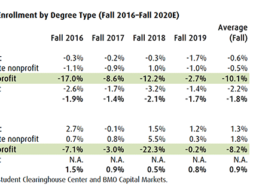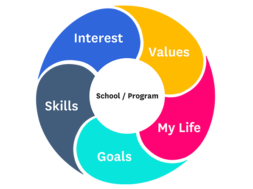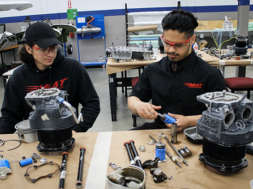
Old School VS New School: Comparing Admissions’ Interactions With Prospects of Non-Profit & For-Profit Schools
By Martin Lind, Education Vertical Director, Velocify and Gregg Meiklejohn, Co-Founder & CEO, Enrollment Resources
Admissions teams at colleges and universities are under increased pressure
A Senate report sent the proprietary school industry reeling in 2012, and created an image problem that the sector has been trying to recover from ever since. But is the stereotype true today? Are for-profit schools aggressive marketers and non-profits passive enrollers? Or are the admissions tactics of non-profit schools getting more competitive and more like their for-profit counterparts because of declining enrollment numbers?
With enrollment down across the board, attracting enough suitable applicants is now a key admissions issue for most higher education institutions, other than a handful of elite private colleges. In 2014, 79 percent of admissions leaders at universities and colleges said they were moderately or very concerned about meeting enrollment goals.
Measuring the impact of declining enrollment on admissions practices
Velocify and Enrollment Resources, two companies with deep admissions experience in North American higher education enrollment, understand that differences between for-profit and non-profit school operations aren’t limited to tax filings. With the rapid growth of students turning to the Internet to research and select the right school program, the companies saw a pressing need for an up-to-date snapshot to verify or disprove these perceptions.
To find out how non-profit school enrollment management tactics measured up against for-profit schools, Velocify and Enrollment Resources conducted a two-part mystery shopper study on responsiveness to student inquiries. Identifying, contacting and engaging student prospects through a consistent and consumer-friendly process is essential for enrollment success at any school.
Part 1 of the study focused on four Key Performance Indicators (KPIs) that are critical measures and indicators of an admissions representative’s response strategy to online inquiries: speed-to-call; speed-to-email; number of call attempts; and number of email attempts.
Part 2 of the study examined school response to phone contact attempts and the user’s experience. The survey noted whether the admissions advisor requested critical caller information during that phone conversation (name, phone, and email), whether they asked questions that invited a prospective student to begin the career/life clarification process and whether they asked to advance the process.
Both parts contacted the same 20 schools: 10 non-profit and 10 for-profit. Because students interested in campus- based programs are often recruited differently than those interested in online programs, all schools were contacted about a program offered online for consistency. Further, the inquiry was focused on an online MBA program where it was available. By attempting to standardize on similar online programs, the survey set out to compare schools that should be competing nationally (and, often, internationally) against one another for the same students.
Methodology
To start, researchers found appropriate online inquiry forms for 10 non-profit and 10 for-profit schools. A total of 100 inquiries (five inquiries per school) were submitted during the school’s business hours and the clock started ticking as soon as forms were submitted. Velocify has performed many analyses of contact strategies that maximize the likelihood of enrollment. The company’s phone and email studies have shown that there is an optimal number of calls and emails, and those contact attempts should be made over 22 days. Therefore, schools in this secret shopper study were given 22 days to respond via phone and email, at which point the following key performance indicators (KPIs) were tracked:
Previous Velocify research, “The Ultimate Contact Strategy,” has found correlations between these KPIs and enrollment rates. By comparing performance in each of these KPIs, Velocify is able to evaluate each school’s effectiveness in responding to online inquiries, which is a proxy for enrollment.
Online inquiry response best practices
The importance of a speedy response
When it comes to the speed of responding to prospective students, faster is better. Research conducted by Zogby Analytics revealed that most prospective students expect to receive a call back within 24 hours of filling out an inquiry form. Furthermore, almost 70 percent believe the first school to call them has an advantage over the competition.1 It is intuitive that the longer these prospective students wait to hear back from a school, the less likely they are to engage and the more likely they are to enroll with a more responsive school. Previous Velocify research validates this assumption: a contact attempt within one minute of inquiry submission increases the likelihood of that prospect turning into an enrolled student by 391 percent.2
Persist, but don’t annoy
When it comes to persistence, it might seem rational to make as many contact attempts as necessary to the inquiry until contact is made. One could also argue that after a couple of failed attempts, admission’s efforts should be diverted to greener pastures. According to Velocify research, the answer is somewhere in between. By looking at data on the progression of millions of prospective students, Velocify uncovered the optimal number of call attempts is six.3 The research shows 93 percent of prospects that eventually enroll have been contacted by the sixth call attempt. When schools continue to dedicate resources into contacting the remaining 7 percent, they begin to experience the effects of diminishing returns, wasting their admissions team’s time on unresponsive prospects and running the risk of being perceived as overly aggressive (as can be seen in the research conducted for this study).
Velocify used a similar methodology to find the optimal email strategy to contact a prospective student. The optimal email contact strategy dictates a response within 20 minutes and a total of five emails sent over a 22 day period. To learn more about optimal inquiry response, please see The Ultimate Contact Strategy.
Speed metrics
From the prospect’s perspective, getting quick, thoughtful attention from a school representative builds confidence, attachment, and interest in the school. Information shared about a school will have a much better chance of getting traction if it is delivered to prospective students within seconds or minutes of their inquiry submission, when they are still thinking about the school and before competing schools have an opportunity to create a wedge and pitch the benefits of their programs. It also tells a prospective student that the school cares about them: “If they are this responsive to my needs now, they will be responsive to my needs when I am a student.” Alternatively, a slow response not only creates a negative impression, but also decreases the probability of enrollment.
When comparing average response times amongst for-profit and non-profit schools, there is no clear winner. As shown in Figure C, for-profit schools responded almost twice as fast on average via phone but responded much slower via email. Although for-profits performed better via phone and non- profits performed better via email, both groups have significant room for improvement compared to best practices.
Speed-to-call attempt
Figure D shows the distribution of initial call attempt times broken up into seconds, minutes, hours, days, and weeks at the prospect level. The most surprising finding for many will be the relatively quick response times by so many non- profit schools, dispelling the myth of their passive admissions process. However, despite the clear benefits of rapid inquiry response, many of the schools studied showed at least some deficiency in their speed-to-call metrics. Perhaps the most surprising finding is that 20 percent of non-profit student prospects in this study did not get a single call, which is double the percentage of for-profit prospects that did not receive a call. While more non-profit prospects received an initial call within 1 minute, there were also more non-profit prospects who waited days or weeks for a first call.
Perhaps some of the non-profit inquiries went unanswered by phone because the typical non-profit admissions office isn’t staffed properly to respond by phone to all incoming inquiries. This may seem perfectly logical to a multi-tasking, over-burdened admissions advisor. But in a market plagued by declining enrollment and increasing competition from schools that perform some phone-based outreach, admissions departments cannot afford to let student prospects fall through the cracks.
Speed-to-email
Non-profit schools have clearly mastered the use of email response as they were more aggressive at responding to inquiries with an email (Figure E). Even if many of the emails were auto-responders that simply acknowledged the receipt of the inquiry, they outperformed for-profit schools in providing a quick outbound contact. Previous Velocify research has shown that the optimal time to email an inquiring prospect is 20 minutes after an inquiry is received.4 Therefore, schools that respond within seconds or minutes are maximizing the value of their inquiries.
It should also be noted that a higher percentage of for-profit prospects received an email within days or weeks compared to non-profit prospects. Every non-profit prospect received at least one email, while 4 percent of for-profit prospects did not receive even a single email. Non-profit schools were also more consistent with the timing of their initial email, indicating the use of more sophisticated email auto-responders.
Persistence metrics
Persistence measures how many contact attempts are made to an inquiry during the study. A gut feeling may make it easy to rationalize the extremes of making too many or too few contact attempts, but Velocify research has shown that the key to a successful contact strategy is to make the optimal number of call-attempts and emails; not too few and not too many. After comparing millions of inquiry records, Velocify research has determined the optimal number of calls is six phone contact attempts to maximize enrollment rates without over- investing time and resources. A similar methodology found that the optimal number of emails to send is five.
Once again, the stereotype of the passive non-profit admissions department was proven false: the average inquiry to one of these schools received 12 calls over the study period, while the stereotypically aggressive for-profit schools only made a few calls more, 16. Moreover, the non-profit schools were more persistent than for-profits on emails, further refuting the popular perception.
On average, both for-profit and non-profit schools were overly persistent via phone. While non-profit schools were closer to the best practice, they still averaged double the recommended six calls. Both groups averaged close to best practice for number of emails which is five. However, as discussed later in this report, the average number of emails sent to non-profit prospects is driven by mostly under-emailed and over-emailed prospects averaging close to best practice.
Number of calls
Figure G shows the distribution of number of calls made to each prospect grouped into four categories based on our best- practice research: those who were under-called, appropriately called, over-called, and extremely over-called. While non-profit schools made double the recommended number of calls on average, it is really a case of how an average is calculated. If you put your head in an oven and your feet in the freezer, your body is – on average – at room temperature, but it is not optimal for your health. Figure G shows that this average is driven by most (58 percent) prospects receiving too few calls and 30 percent receiving far too many calls. In some extreme cases, non- profit prospects received more than 50 calls, which is far more aggressive than most imagine a for-profit admissions team might be. Just as calling too infrequently can lead to wasted opportunity, calling too frequently can be a costly mistake, not only wasting resources but hurting your school’s reputation. By failing to put enough effort into contacting prospects quickly and with optimal frequency, schools could be missing out on an easy, cost-efficient best practice to improve their overall enrollment yield.
In contrast, the for-profit average is driven by most prospects receiving too many calls. More than 40 percent of the for-profit prospects were called more than 12 times, too many to maximize the likelihood of enrollment.
Number of emails
Figure H shows the distribution of number of emails sent to prospects. While the average number of emails was close to best practice, few non-profit prospects actually received the optimal number of emails. Instead, as was the case with calling persistence, the appearance of a best-practice average is really the result of a high percentage of under-emailed and over- emailed prospects along with a low percentage of appropriately emailed prospects. With the vast majority of inquiries receiving more than seven emails over 22 days, the image of the passive non-profit admissions team is further eroded.
In contrast, the for-profit average is the result of many prospects receiving the optimal number of emails. More than 35 percent of for-profit prospects received between four and six emails compared to 12 percent of non-profit prospects.
Inbound call best practices
Individuals in the school selection process are in the midst of determining the best way to invest in their future. Productive, personalized discovery conversations with admissions advisors support that decision process and build excitement and enthusiasm for a school’s programs.
Part 2 of the study looked at the prevalence of productive communications best practices by examining whether the admissions advisor who answered the phone requested the needed information during that phone conversation, whether they asked questions that invited a prospective student to begin the career/life clarification process and whether they attempted to advance the enrollment process.
As with Part 1 of the study, the resulting data indicates a variety of response strategies and a wide range of performance in terms of responsiveness. The performance demonstrated during the study showed that non-profit schools are losing well-qualified inquiries through benign neglect and transactional instead of personalized communications. For- profit schools seem to be more aware of the impact of a first impression and, on the whole, are more adept at providing a better “user experience” for prospective students who call in with questions.
Part 2 methodology
For this part of the mystery shopper survey, Enrollment Resources contacted the same 10 for-profit and 10 non-profit schools as Part 1 via phone, pretending to be prospective students. Shoppers were given a mainstream premise and were told to express an interest in going back to school. Shoppers called each school twice within the school’s business hours through the month of September and October using a Spoof Card, which allows the phone call origin to display as a call local to the school. This eliminates the possibility of a school cherry-picking inbound calls based on the location of the caller. The user experience was reported into a best-practice survey instrument designed and refined by Enrollment Resources. The aggregate averages for both for-profit and non-profit schools have been compared and analyzed against best practice enrollment management KPIs.
First point of contact: collecting core information
Reception asked for caller’s name and phone number
The receptionist at a school makes the first impression with a prospective student. What they say, how they say it, and the timing of what they say can impress or put off a caller, yet many of the callers in the study were not treated with courtesy or efficiency.
Asking a caller’s name is a very basic way to establish a connection and a fundamental part of a service culture. Asking an inquiry for a phone number allows for both follow up and the ability to reconnect right away should the call be disconnected. Schools less likely to communicate with prospective students over the phone would logically be less rigorous in asking for an inbound caller’s contact information.
In general, it is acknowledged that non-profit schools get more inbound phone inquiries than for-profit schools. In spite of this, only 37 percent of non-profit schools asked for the caller’s name and half were asked for their phone number. For-profits actually performed better see (see Figure K), with 87 percent of receptionists asking for a name and nearly three in four (73 percent) requesting a phone number.
Caller was transferred from one admissions advisor to another
When a prospective student is committing to a significant life change such as continuing their education, the most effective and courteous behavior is for the first point of contact to stay with the prospective student until they are speaking with the person who can best help them.
Within this study, over one third of prospective students were sent to a voice mail, got moved around among the admissions team, or put on hold. Making first contact a chore for prospective students opens the door for a competitive school to easily stand out by being more attentive with the prospect.
A bad first impression can lead the inquirer to believe that their time at the school will be filled with poor customer service.
As previously discussed, schools more experienced with inbound callers should be more sensitive to their experiences. For-profit schools were better than their non-profit cousins: 7 percent of inbound calls were sent to a voicemail, moved around multiple times or put on hold, while 38 percent of inquiries to non-profit schools were treated this way.
If admissions advisor was not immediately available, reception asked caller to book an appointment
If an admissions advisor or subject expert is not available, the best practice is to have the first point of contact schedule a call between an admissions advisor and the prospective student. Both sectors, and for-profit schools in particular, did a poor job of taking advantage of the opportunity to book a call between a prospective student and a subject expert (see Figure K). Of the eight instances where a for-profit receptionist could have set a follow-up appointment, none actually did, and only two of the five non- profit receptionists did when they had the opportunity.
Prospective student user experience with admissions advisor or subject expert
In order to properly support a student in their school selection process, there needs to be a meaningful series of exchanges that will help the student gain clarity of their life path. This is one of the most important roles for an admissions advisor. If admissions advisors do not even invite prospective students to begin the career planning process, they are doing the student and their school a disservice. Moreover, it is a significant missed opportunity for the school and leaves the door open for competing schools.
Admissions advisor asked callers for their name
As discussed above, a basic premise of any service culture is to exchange names during a phone call. More than 40 percent of admissions advisors in the non-profit sector did not have the common courtesy to ask for the caller’s name. Continuing the trend of experience with phone-based outreach, nearly 83 percent of admissions advisors at for-profit schools did ask for a name.
Admissions advisor asked open, engaging questions, initiating a meaningful conversation
The best way to assess whether the goals of a potential student are a good fit for a school is to delve into the life goals of the caller. Examples of these types of open-ended questions include, “What makes you interested in this program? Why now?” “How long have you been thinking about going back to school?” and “What research have you done so far into schools, programs, and the job market?” Both for-profit and non-profit schools were uneven, at best, in using enrollment qualification best practices with 72 percent of for-profit inquiries and 53 percent of non-profit inquires being asked such questions. It seems a significant percentage of schools, non-profit in particular, are more transactional in their enrollment processes.
Caller was asked to schedule a school tour
All schools in the study were called about an online program. Though touring an online “campus” is not possible, offering a “tour” of a typical online student’s experience is a best practice to effectively prepare the inquirer for what to expect. After an admissions advisor determines that the caller is a good fit for the school, they should schedule such a tour to advance the prospect down the enrollment funnel. For-profit schools did not ask to advance the admissions process by scheduling a tour 44 percent of the time. Non-profit schools did not advance the process 76 percent of the time, a major failure and yet another missed opportunity to strengthen chances of enrolling the student.
Conclusions
Every one of the non-profit and for-profit schools studied underperformed on key inquiry response benchmarks. No school showed consistent, across-the-board success that would maximize the chances of enrolling the highest number of qualified prospects.
The data indicate that non-profits have invested in processes and technologies that enable them to respond rapidly to inquiries via email, one of the KPIs for maximizing their relationship-building opportunity with prospective students. But at the same time, a number of non-profit schools underperformed against best practices in email persistence and dramatically underperformed in call responsiveness.
Velocify routinely conducts secret shopper studies like this across multiple industries. In most every case, companies don’t call back their inquiries more than once or twice. Notably, inquiries to both types of schools in this study were generally overcalled to the point of annoyance, wasting school resources and potentially hurting the reputations of the schools.
In addition, both non-profits and for-profits are seriously undermining their own efforts to meet enrollment goals due to complacent and even missing admissions processes. Schools generally did not spend quality time exploring life plans for their prospective students. The admissions process might be largely described as transactional and benign, at best. Weak response processes at non-profit schools, such as potentially wasting half of their inbound inquiries by not asking for a phone number, could translate into millions of dollars of lost enrollment revenue per month for a medium-sized community college. With these weak processes, non-profit schools are limiting their enrollment yield potential, frustrating prospective students, and diminishing the effectiveness of their enrollment management effort.
Ultimately, at many of the schools surveyed, there is a substantial opportunity to improve performance across most of the benchmarks, most notably speed to call, persistence and user experience consistency. By focusing on the four KPIs and user experience best practices outlined in this report, admissions departments can work smarter, increasing contact rates and appointments to help meet enrollment goals without significant additional marketing spend.
1 Zogby Analytics, Online Prospect Expectations, http://pages.velocify.com/OnlineProspectExpectations.html
2 Velocify, The Ultimate Contact Strategy, http://pages.velocify.com/rs/leads360/images/Ultimate-Contact-Strategy.pdf
3 Velocify, The Ultimate Contact Strategy, http://pages.velocify.com/rs/leads360/images/Ultimate-Contact-Strategy.pdf
4 Velocify, The Ultimate Contact Strategy, http://pages.velocify.com/rs/leads360/images/Ultimate-Contact-Strategy.pdf

Martin Lind oversees the business development, product marketing and thought leadership for Velocify’s enrollment management solution. Prior to joining Velocify, Mr. Lind was the director of product management at Blackboard Connect and also held manager-level positions at 20th Century Fox and eToys.com. A published author and in-demand speaker, Lind has led educational sessions on higher education marketing and admissions matters at APSCU, FAPSC, AACS, ACCET, FAME, DETC, EduComm and the Jenzabar Annual Meeting among others. He has written articles for University Business, Career Education Review, Today’s Campus, BeautyLink and Government Technology Magazine. Mr. Lind holds a Masters of Public Administration from USC and a BA in political science from the University of Pennsylvania.
Contact Information: Martin Lind // Education Vertical // Velocify // 222 North Sepulveda Blvd, 18th Floor El Segundo, CA 90245 // Phone: 877-645-7918 // Education@Velocify.com

Gregg Meiklejohn specializes in strategic marketing. He is an expert in branding businesses through online and traditional public relations tactics. Gregg developed the award winning program Knowledge Communities, which has consistently given clients massive returns at pennies on the dollar (when compared to advertising). He is our company’s Scenario Planner, analyzing and calling industry trends before they emerge into public view. Gregg has over 20 years of marketing experience and frequently delivers workshops and teaching sessions via Webinar and at conferences North America wide.
Contact Information: Gregg Meiklejohn // Co-Founder & CEO // Enrollment Resources // 103-2787 Jacklin Rd Victoria, BC V9B 3X7 // Phone: 250-391-9494 // info@enrollmentresources.com










